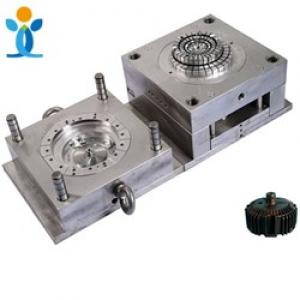Design rules of mould cooling system
Design rules of mould cooling system
In injection mold, the design of cooling system is very important. This is because only when the molded plastic products are cooled and solidified to a certain rigidity, can the plastic products avoid deformation due to external force after demoulding. Because the cooling time accounts for about 70% - 80% of the whole molding cycle, the well designed cooling system can greatly shorten the molding time, improve the injection productivity and reduce the cost.
Improper design of the cooling system will make the molding time longer and increase the cost; uneven cooling will further cause warpage and deformation of plastic products.According to the experiment, the heat from the melt into the mold is divided into two parts, one part is transferred to the atmosphere by radiation and convection, the other 95% is transferred from the melt to the mold. Due to the function of cooling water pipe in the mold, the heat of plastic products is transferred from the plastic in the mold cavity to the cooling water pipe through heat conduction through the mold base, and then taken away by the coolant through heat convection. A small number of heat that is not taken away by the cooling water will continue to conduct in the mold, and will be scattered in the air after contacting with the outside world.
The molding cycle of injection molding consists of closing time, filling time, holding time, cooling time and demoulding time. Among them, cooling time accounts for the largest proportion, about 70% - 80%. Therefore, the cooling time will directly affect the molding cycle and output of plastic products. During the demoulding stage, the temperature of the plastic products shall be cooled to a temperature lower than the thermal deformation temperature of the plastic products, so as to prevent the plastic products from warping and deformation caused by the relaxation phenomenon caused by the residual stress or the external force of demoulding.
The factors affecting the cooling rate of products are as follows:
Plastic products design. Mainly plastic products wall thickness. The greater the thickness of the product, the longer the cooling time. Generally speaking, the cooling time is approximately proportional to the square of the thickness of the plastic product, or to the 1.6 power of the maximum channel diameter. That is to say, the thickness of plastic products is doubled and the cooling time is increased by 4 times.
Mold material and cooling method. Mold material, including mold core, cavity material and mold base material, has a great influence on cooling rate. The higher the heat conduction coefficient of die material, the better the effect of heat transfer from plastic in unit time, and the shorter the cooling time.
Cooling water pipe configuration. The closer the cooling water pipe is to the mold cavity, the larger the pipe diameter, the more the number, the better the cooling effect and the shorter the cooling time.
Coolant flow. The larger the flow rate of cooling water is, the better the effect is.
The nature of the coolant. The viscosity and thermal conductivity of the coolant also affect the heat conduction effect of the mold. The lower the viscosity of the coolant, the higher the thermal conductivity and the lower the temperature, the better the cooling effect.
Plastic selection. Plastic is a measure of the speed at which plastic conducts heat from a hot place to a cold place. The higher the heat transfer coefficient of plastic, the better the heat transfer effect, or the lower the specific heat of plastic, the temperature is easy to change, so the heat is easy to escape, the better the heat transfer effect, and the shorter the cooling time.
Processing parameter setting. The higher the material temperature, the higher the mold temperature, the lower the ejection temperature and the longer the cooling time.
Design rules of cooling system
The designed cooling channel shall ensure uniform and rapid cooling effect.
The cooling system is designed to maintain proper and efficient cooling of the mold. Cooling holes shall be of standard size to facilitate machining and assembly.
When designing the cooling system, the mold designer must determine the following design parameters according to the wall thickness and volume of the plastic part: the location and size of the cooling hole, the length of the hole, the type of hole, the configuration and connection of the hole, and the flow rate and heat transfer property of the coolant.


